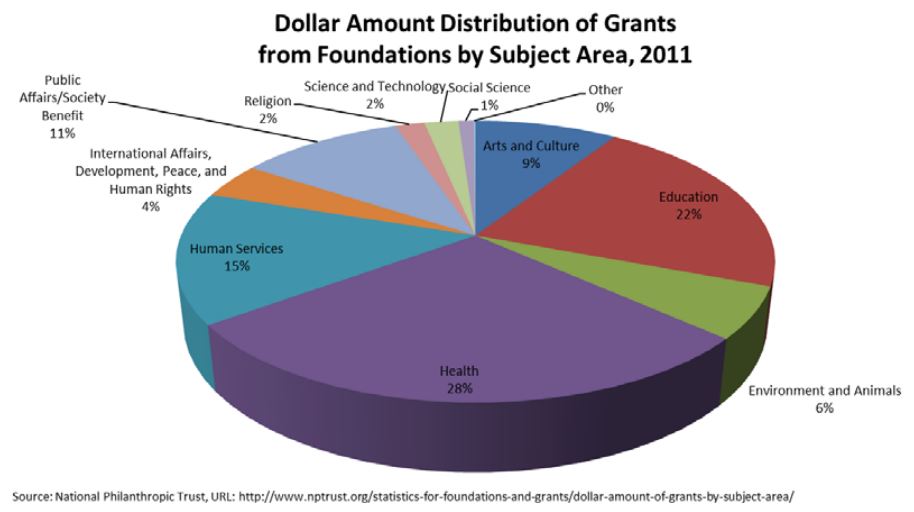What must you consider when pursuing Grant Funding?
Grant Funding Possibilities
There is a considerable amount of grant funding in the United States from both foundation and government sources designed to fund a vast array of programs and projects. Nonprofit organizations that are interested in winning grant award funding should consider several factors: the grant funding environment, myths and misconceptions, unconventional wisdom, and strategies for pursuing grant funding.
The Grant Funding Environment
In the United States today there is a large amount of private and public money devoted to common causes. In 2014, the total of government and philanthropic funding exceeded $656 billion. Of that funding, roughly $602.6 billion was government grant funding[1] and $53.7 billion was foundation funding[2]. Funding varies by nonprofit subject area. Foundation giving in 2011 is shown in Figure 1 below. Most grant funding goes to health and human services, education, and public affairs/society benefit.
FIGURE 1.

Most of this money is sought after through a competitive process of grant proposal submissions. However, it is certainly worth the time and effort to pursue grant funding given the sheer volume of funding that exists.
Recent research has found that diversifying funding sources is a much better strategy for nonprofit organizations to weather a difficult economic environment (Froelich, 1999; Caroll & Stater, 2009). Grant money is certainly a good alternative funding source. However, it requires the appropriate internal systems to ensure strong and consistent funding.

Grant Funding Misconceptions
To be sure, there are many myths and misconceptions regarding grants and grant-writing. Before we begin, we attempt to tackle these fallacies in turn (adapted from Fitz 2015).
- Winning Grant Funding is Easy – winning grants is not easy and it is a very labor-intensive process. Don’t fool yourself into thinking its easy money. Winning grant funding requires deliberate planning, focus, practice, and hard work.
- We Can Rely Solely On Grant Funding - grants should not be considered a sole source of funding for an organization. Grant funding can be scarce in a tough economic environment and competitive in a favorable economy and funding sources should be diversified. However, this shouldn’t deter you from trying to obtain grant funding because it can certainly be a boon to an organization when you do win funding.
- Grant Funding Is Too Competitive - grant funding is competitive, but it is also very rewarding. Again, it requires a strong grant system to achieve consistent awards.
- Grant Funding Is Too Expensive - when starting out, pursuing grant funding can be costly, but training your staff to become strong grant writers will yield a strong ROI.
- We Don’t Have Anyone on Staff Who Can Write Grants - grant-writing is not complicated, it just involves dedication and honed skill. Even if you don’t have staff who are knowledgeable in grant-writing, challenge them to become experts and design a training program around it.
To conclude, grant-writing is a process and in committing to it, you will be devoting yourself to building a grant system.
Unconventional Wisdom
There are a few things to consider when pursuing grant money that no one will tell you prior to starting this process.
- There Is Little to No Grant Money in Operations – grant funding doesn’t provide money for operational expenses for a nonprofit. Bear this in mind when pursuing grant money. Donations and other organizational income need to continue to be channeled into operations while grant funding will have a specific purpose (Selinger, 2009).
- There Is Little to No Grant Money in Sustainability – grant funders often want to know how you intend on making the program or project continue beyond the current grant funding specified in the award. The reality is that once a project is funded it isn’t typically sustained by the original funder. You should keep this in mind if your objective is to sustain a particular project and other funding sources may need to be diverted in order to meet those needs (Selinger, 2010).
- Government vs. Foundation Funding Trade-offs – the type of grant funding you receive also matters. Government grants will provide the biggest pay-off but are much more labor intensive. Foundation grants offer smaller awards but are less laborious and time consuming (Sanders, 2016). However, a good strategy is to determine funding sources for both types and learn to work with them both.
Strategies For Achieving Grant Funding
Create a List of Funders – Do some online research and start a list of potential grant funding sources. Grant funding from government sources and from private or public foundations is usually based on subject and geographic region – so be sure these criteria fit your organization. Once you’ve narrowed down some eligible funding sources, begin cataloguing information on them in an Excel spreadsheet: name, mission statement, website, contact information, staff, and board of governors/trustees.
Cultivate Relationships with Funders – Before you start this process be sure you do your homework first. Read through the mission statements and history of these organizations before you approach them so you can establish that your organization’s goals align with theirs. Then work towards cultivating relationships with foundation management and/or board of directors or government agency staff. It’s important that you aren’t blindly throwing proposals at these organizations. You need to get to know management and governing board members if you want to have a better shot at getting awards[3].
Look for Innovative Ideas and Strong Methods – Become familiar with innovative project ideas and strong methodologies for evaluation. Take the time to review the literature in your field to become more aware of what constitutes cutting edge research and monitoring and evaluation. Look to the more popular peer-reviewed academic journals in your field with high impact factors to review the most highly cited works.[4] You always want to consider testing new programs that will likely have a strong impact on your beneficiaries, but at the same time consider how you can implement these programs so that it will help you identify whether the program is working or not.[5]
Have a Strong and Credible Staff at the Ready – Have staff with strong credentials to oversee program implementation and evaluation of these projects should an award be granted. This really needs to be assessed before you start writing the grant because it may require resources that you don’t have access to. You don’t want to be awarded a grant and not be ready to implement the program. Have a running list of personnel within your organization or outside your organization that you would tap for a project. Be sure to include them within the budget when you write these grants. In addition, have staff bios or CVs at the ready to submit in the appendix of your grant proposals. Also consider working with experienced grant writers to set up standard pieces of your grant proposals, as well as reviewing and polishing your proposals.
Establish a Grant Funding System – In order to pursue grant funding and do it well, you must commit to a grant system. This ‘system’ does not necessarily guarantee that you’ll get stellar grant funding immediately or every time, but it will certainly enhance your chances of winning grant funding. The system is comprised of a series of procedures, each inter-related in how they contribute to the overall grant system. However, once these procedures have been put in place and appropriate processes for operating them established, the only component that really requires a constant overview is prioritizing grants for the organization and assigning them and evaluating performance. The rest requires only periodic adjustment. We’ll cover the grant system in more detail in the supplement to this paper.
Grants can be a strong supplement to your organization’s income. However, you need to be prepared for the intense competition, the time/labor investment, and the limitations involved. However, there are excellent strategies that your organization can employ to begin the process toward winning funding.
[1] This statistic was sourced from USASpending.gov website: https://www.usaspending.gov/Pages/TextView.aspx?data=OverviewOfAwardsByFiscalYearTextView
[2] This statistic was sourced from the National Philanthropic Trust website: http://www.nptrust.org/philanthropic-resources/charitable-giving-statistics/
[3] An excellent resource for learning more about how to approach foundations can be found here: http://grantspace.org/tools/knowledge-base/Funding-Resources/Foundations/approaching-foundations.
[4] For some excellent resources, start here: EBSCO for nonprofits, https://www.ebscohost.com/corporate-research/nonprofit-organization-reference-center, Nonprofit and Voluntary Sector Quarterly, http://nvs.sagepub.com/, and for a general directory of sources, University of Michigan Research Guides http://guides.lib.umich.edu/c.php?g=283253&p=1886821.
[5] Randomized controlled trials (RCT) are the gold standard of experimental evaluation in the sciences. However, you may not have the resources, personnel, or capability to conduct an RCT. In addition, an RCT might not make sense with regard to your population of beneficiaries or the outcome measures that you are interested in. There are many other methods that can provide solid inference regarding whether programs are achieving their objectives. Providing strong innovative programming and methods in grant proposals will establish credibility with grant sources and generate interest for you project particularly if it can be a model for academic research.
Sources
Fitz, Joanne (2015) 8 Grant Writing Myths Busted. About.com. URL: http://nonprofit.about.com/od/foundationfundinggrants/a/8-Grant-Writing-Myths-Busted.htm.
Froelich, Karen A. (1999) Diversification of Revenue Strategies: Evolving Resource Dependence in Nonprofit Organizations. Nonprofit and Voluntary Sector Quarterly. 28(3): 246-268
Caroll Deborah A. and Keely Jones Stater (2009) Revenue Diversification in Nonprofit Organizations: Does it Lead to Financial Stability? Journal of Public Administration Research and Theory. 19: 947-966.
Sanders, Sherie (2016) Federal vs. Foundation Funding – Embrace Them Both. eCivis. URL: http://blog.ecivis.com/federal-vs-foundation-funding.
Selinger, Jake (2009) Bratwurst and Grant Project Sustainability: A Beautiful Dream Wrapped in a Bun. Selinger and Associates Grant Writing. URL: http://seliger.com/2009/07/19/bratwurst-and-grant/.
Selinger, Jake (2010) The Real World and the Proposal World. Selinger and Associates Grant Writing. URL: http://seliger.com/2010/04/11/the-real-world-and-the-proposal-world/.
From ‘Charitable Giving Statistics,’ National Philanthropic Trust. URL: http://www.nptrust.org/philanthropic-resources/charitable-giving-statistics/.
From ‘Overview of Awards By 2008-2015,’ USAspending.gov. URL: https://www.usaspending.gov/Pages/TextView.aspx?data=OverviewOfAwardsByFiscalYearTextView.
